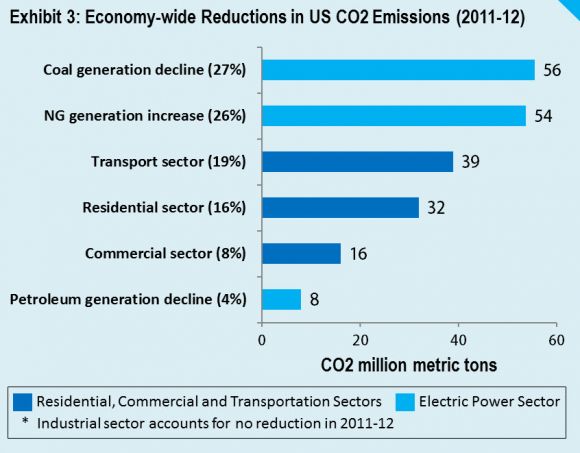Ever since it was reported last year that U.S. CO2 emissions had dropped to a twenty-year low, energy analysts and bloggers have engaged in a friendly academic tussle over the cause of the drop.
The conventional wisdom in the popular press is that natural gas played the dominant role by pushing coal out of the market. The Energy Information Administration also supports this in its analysis. But the folks at CO2 Scorecard have come to a different conclusion: the historic 2012 drop in emissions was driven more by economy-wide efficiency than an increase in natural gas generation.
This isn't the first time CO2 Scorecard has challenged the assumption that natural gas is America's CO2 savior. A paper released last fall analyzing emissions reductions from January to March of 2012 found that the unusually warm winter accounted for 43 percent of the drop, while the displacement of coal with natural gas only accounted for 21 percent.
Now that the full numbers for 2012 are out, analysts have a better window into what's driving America's changing emissions profile. Once again, the folks at CO2 Scorecard found that natural gas accounted for only one quarter of last year's reductions.
"Contrary to popular perception, 2012 data shows that the increased use of natural gas in the electric power sector is not the largest contributor of energy-related CO2 reductions in the U.S. over the past year. Nearly 75 percent of the CO2 savings are attributable to economy-wide demand reduction driven by energy efficiency, conservation and the mild winter of the first quarter of 2012," write Shakeb Afsah and Kendyl Salcito in their analysis.
The analysts took a deeper dive into the different NERC regions that make up the U.S. electricity grid. They found that in five of the eight regions, the decline in coal generation was greater than the increase in natural gas generation. On a nationwide level, more than 50 million megawatt-hours of coal simply dropped off the map without any assistance from natural gas -- a result of the decline in electricity consumption. And in some areas, natural gas actually displaced more hydro and nuclear than coal, thus adding to emissions.
When combining all these factors together, CO2 Scorecard determined that increases in natural gas generation were responsible for 26 percent of the total decline in CO2 emissions in 2012. In comparison, the researchers found that the drop in coal consumption due to a decrease in electricity demand and the retirement of old plants played a slightly bigger role at 27 percent.

The rest of the reductions came from a decline in driving, an increase in fuel-efficient cars and a decrease in residential and commercial energy consumption. While last year's warmer winter caused a drop of 45 million tons of CO2, the analysts conclude that 100 million metric tons were saved due to a drop in demand for energy due to efficiency measures.
"By far, demand reduction through energy efficiency and conservation measures in the transportation, residential and commercial sectors had the largest impact on CO2 savings -- nearly two times more than the effect of natural gas. In addition to their significance, these changes are also likely to be most stable," write Afsah and Salcito.
This analysis will likely add to the academic debate around U.S. emissions reductions rather than settle it, as there are many varying assumptions about what energy source is replacing what. But even if the study understates the role of gas in dropping emissions, the economy-wide impact of efficiency -- particularly when it cuts coal out of the picture -- is still substantial. The only way to continue steady reductions, say the researchers, is to put in place a long-term policy solution that encourages energy reductions, not just pushing a bonanza of natural gas production.
"The policy lesson is obvious -- real and lasting reductions in CO2 come from economy-wide policy effects, not from the current transient boom in the U.S. natural gas market. Therefore, the best way to ensure continued economy-wide reductions in CO2 emissions is through a carbon tax," the authors conclude.



